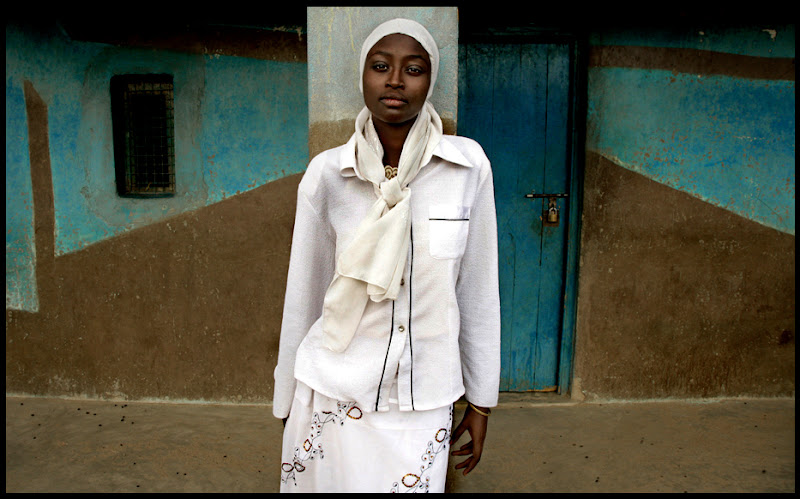CAPTION: "Therapeutic Feeding Center 1"
In villages like Marsabit, located in the southeastern edges of the Chalbi Desert, small "clinics" provide basic health and medical care to the the Rendille, Samburu,Turkana and Gabra nomadic tribes. As pastoralists, all of them have thrived in Kenya's northern deserts known as "the arid lands" for generations, and are trying to survive the harsh conditions of lost crops and livestock as a result of the on going drought.
In this image, a young child suffering from severe malnutrition waits her turn yet grows anxious with fitful cries...quietly calmed under the ever watchful presence of her mother...while a portion of "plumpy nut," a vitamin rich peanut butter like foodstuff is prepared - vital in bringing the child back from the edges of starvation.
I can't say that seeing hardship, especially when it affects young children and babies, hasn't left scars on my heart because it has and would anyone with a beating heart in their chest. When some would safely and naturally keep their distance, you instinctively walk closer while slowly measuring the dynamics of the moment. In this instance, a glance with the mother for approval...while you kneel and slowly invade their personal space for just one moment, to document the issues in play so far from sight. You try not to be overwhelmed by her piercing cries, the smell of sickness and when you break from your composition...the seeing...the sight of such a frail little child in such distress - proves hard on everyone.
As a mature photographer, like many of my contemporaries, the way I see is instinctual. I don't need to concern myself with the technical aspects of an image nor it's aesthetics - well beyond this now. However it's the human skills I need, to help me see what's happening in front of me...to recognize the possibilities, to sense the evolving moments that may present an image of consequence, to position yourself, to know when to wait and when to push - this proves to be exhausting. This particular image, it's rough set of tones originally shot in colour, suspends the moment and feels "right" in black and white.
More importantly than this one image is that this child, via a long, slow process of therapeutic feeding and constant care by her mother, was on her way back to normal weight and improved health.
*This image was produced under a commission by FH, to help support, to help raise awareness, to the issues caused by the ongoing drought in the arid lands of northern Kenya.
*Food for the Hungry (FH) has been working the back roads of Kenya since the early 70's and they continue without fanfare, the daily tasks of caring for their community.
In this image, a young child suffering from severe malnutrition waits her turn yet grows anxious with fitful cries...quietly calmed under the ever watchful presence of her mother...while a portion of "plumpy nut," a vitamin rich peanut butter like foodstuff is prepared - vital in bringing the child back from the edges of starvation.
I can't say that seeing hardship, especially when it affects young children and babies, hasn't left scars on my heart because it has and would anyone with a beating heart in their chest. When some would safely and naturally keep their distance, you instinctively walk closer while slowly measuring the dynamics of the moment. In this instance, a glance with the mother for approval...while you kneel and slowly invade their personal space for just one moment, to document the issues in play so far from sight. You try not to be overwhelmed by her piercing cries, the smell of sickness and when you break from your composition...the seeing...the sight of such a frail little child in such distress - proves hard on everyone.
As a mature photographer, like many of my contemporaries, the way I see is instinctual. I don't need to concern myself with the technical aspects of an image nor it's aesthetics - well beyond this now. However it's the human skills I need, to help me see what's happening in front of me...to recognize the possibilities, to sense the evolving moments that may present an image of consequence, to position yourself, to know when to wait and when to push - this proves to be exhausting. This particular image, it's rough set of tones originally shot in colour, suspends the moment and feels "right" in black and white.
More importantly than this one image is that this child, via a long, slow process of therapeutic feeding and constant care by her mother, was on her way back to normal weight and improved health.
*This image was produced under a commission by FH, to help support, to help raise awareness, to the issues caused by the ongoing drought in the arid lands of northern Kenya.
*Food for the Hungry (FH) has been working the back roads of Kenya since the early 70's and they continue without fanfare, the daily tasks of caring for their community.




